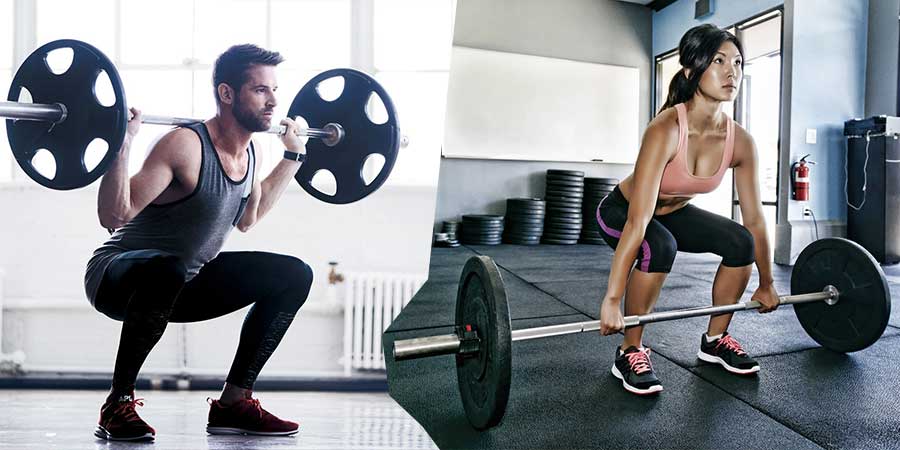Fit for Two: Exercise Guidelines During Pregnancy
- 13 Apr - 19 Apr, 2024
Heading over to the free weights area in the gym can be a daunting prospect and often leaves you fraught with questions, especially when barbells and plates are being dropped on the floor, benches and racks are surrounded by people in specialist lifting gear, and making eye contact with by passers only results in death stares and grunts.

“Why is that girl wearing weird shoes and a belt?” “Why does that guy drop his barbell on the floor so aggressively? “Why are you arching your back on the bench so much, surely that’s bad for you?” “Why is that guy posing and flexing in the mirror, surely he should be working out in the gym not just preening?”
Chances are, the confusion stems from witnessing three distinct types of weight lifting sports which to the untrained eye can look pretty similar, but hopefully this article can clear up some common misconceptions!
What is bodybuilding?
Bodybuilding focuses on aesthetics rather than strength, with the goal of developing muscle size and shape that is symmetrical and pleasing to the eye. Bodybuilder’s training style focuses on ‘hypertrophy’ (or muscle growth), fat loss, and contest preparation. ÊBodybuilding as a competitive activity is for both men and women, and depending on their federation affiliation, they can be categorised by height, weight, age, body goal category, and even by disability.
Although bodybuilding training still incorporates the ‘big three’ compound lifts – the squat, the bench and the deadlift, a typical training split emphasises isolation exercises (which only involve one joint and fewer muscle groups) for each body part. Rep ranges for individual exercises are high, generally in the eight-12 or 12-15 range and are often performed in ‘super set’, where one exercise is immediately followed by another without a rest period.
Cardio and diet also play a huge part in a bodybuilding programme, as fat loss and maintaining a lean physique are incredibly important. ÊSerious bodybuilding is a lifestyle requiring complete dedication, since what you eat and spend your time doing outside of the gym is equally important as the time you spend training!
What is powerlifting?
Powerlifting focuses on brute strength in a single plane of motion. Competitors lift as heavy as possible on the three core movements – the squat, the bench and the deadlift. Rep ranges for each exercise are normally in the two-five per set and rest periods are much longer. Isolation exercises still feature in a powerlifting training programme but they take much more of a back seat, and unlike in bodybuilding, cardio and strict dieting are definitely not a priority, as all energy needs to go into lifting as much as possible!Ê In the broadest possible terms, while bodybuilders focus on muscle for “show” and are not necessarily concerned about how strong they are, powerlifters have no interest in looking buff, they just want to be strong!
As the name suggests, Olympic lifting is the kind of weightlifting you see in the Olympics and the lifts are very technical and different from those seen in powerlifting and bodybuilding. Training revolves around the main compound lifts performed in competition – the ‘snatch’ and the ‘clean and jerk’. There is a huge emphasis on technique in an Olympic weightlifting training programme, so entire workouts may revolve around building explosive power in one phase of one lift, while other workouts may focus building overall strength with other complementary compound movements like front squats, overhead press, and deadlifts. Rep ranges for each exercise is normally in the two-six range and rest periods are long (three-five minutes).
So which type of lifting is best for you?
In summary, bodybuilding places its emphasis on hypertrophy, fat loss, and diet. Powerlifting focuses on strength in three main lifts, utilises a lower rep range and a slower tempo of movements during training. Olympic weightlifting incorporates aspects of strength, power, speed, and mobility with movements that are very technical and performed at a high tempo.
All three are advanced forms of strength training, so if you're just getting started with exercise or have any physical limitations or chronic disease, you're better offÊstarting with a more basic strength training approach. Once you're comfortable with light to moderate weights, you can try more advanced styles.
All of these styles will help you develop strength and power and impact your body composition by increasing muscle mass, but unless you're looking to compete, combining aspects of all of the formats is probably your best bet.
An integrated approach to fitness combines multiple forms of exercise into a progressive system. That means bringing together weightlifting, bodybuilding, powerlifting and other forms of exercise, such as stretching, cardiovascular, and core exercises. Ultimately, whatever style you enjoy the most will be the one you stick with, so it's worth exploring them all and committing to what works for you.
COMMENTS